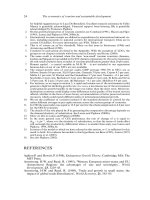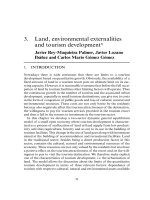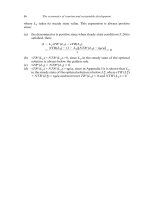THE ECONOMICS OF MONEY,BANKING, AND FINANCIAL MARKETS 184
Bạn đang xem bản rút gọn của tài liệu. Xem và tải ngay bản đầy đủ của tài liệu tại đây (34.49 KB, 1 trang )
152
PA R T I I
Financial Markets
The efficient market hypothesis also views expectations of future prices as
equal to optimal forecasts using all currently available information. In other words,
the market s expectations of future securities prices are rational, so that:
P te+1 * P tof+ 1
which in turn implies that the expected return on the security will equal the optimal
forecast of the return:
R e * R of
(10)
Unfortunately, we cannot observe either R e or P et + 1, so the rational expectations
equations by themselves do not tell us much about how the financial market behaves.
However, if we can devise some way to measure the value of R e, these equations will
have important implications for how prices of securities change in financial markets.
The supply and demand analysis of the bond market developed in Chapter 5
shows us that the expected return on a security (the interest rate, in the case of
the bond examined) will have a tendency to head toward the equilibrium return
that equates the quantity demanded to the quantity supplied. Supply and demand
analysis enables us to determine the expected return on a security with the following equilibrium condition: The expected return on a security R e equals the equilibrium return R *, which equates the quantity of the security demanded to the
quantity supplied; that is,
Re * R*
(11)
The academic field of finance explores the factors (risk and liquidity, for example)
that influence the equilibrium returns on securities. For our purposes, it is sufficient to know that we can determine the equilibrium return and thus determine
the expected return with the equilibrium condition.
We can derive an equation to describe pricing behaviour in an efficient market
by using the equilibrium condition to replace R e with R * in the rational expectations equation (Equation 10). In this way, we obtain:
R of * R *
(12)
This equation tells us that current prices in a financial market will be set so
that the optimal forecast of a security s return using all available information equals the security s equilibrium return. Financial economists state it
more simply: In an efficient market, a security s price fully reflects all available
information.









